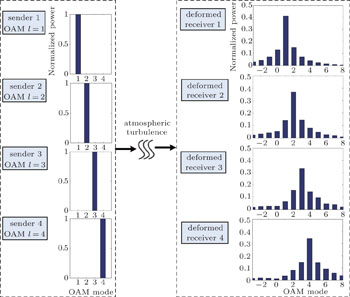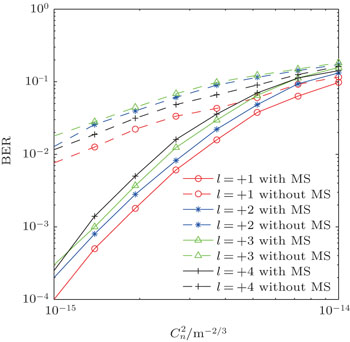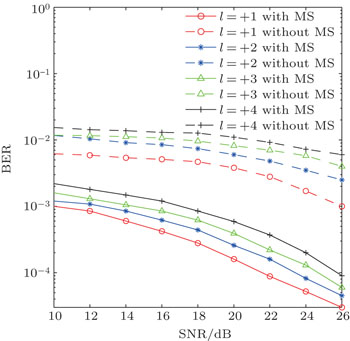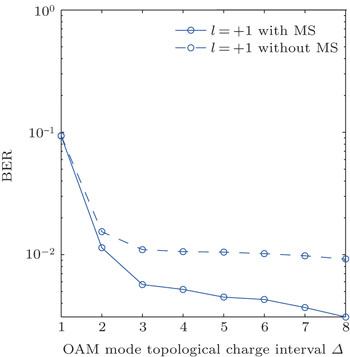† Corresponding author. E-mail:
Project supported by the National Natural Science Foundation of China (Grant Nos. 61271238 and 61475075), the Open Research Fund of Key Lab of Broadband Wireless Communication and Sensor Network Technology, Ministry of Education, China (Grant No. NYKL2015011), the Postgraduate Innovation Research Plan of Jiangsu Province, China (Grant No. CXZZ13_0489), and the University Natural Science Foundation of Jiangsu Province, China (Grant No. 16KJB510037).
Atmospheric turbulence (AT) induced crosstalk can significantly impair the performance of a free-space optical (FSO) communication link using orbital angular momentum (OAM) multiplexing. In this paper, we propose a multiple-user detection (MUD) turbulence mitigation scheme in an OAM-multiplexed FSO communication link. First, we present a MUD equivalent communication model for an OAM-multiplexed FSO communication link under AT. In the equivalent model, each input bit stream represents one user’s information. The deformed OAM spatial modes caused by AT, instead of the pure OAM spatial modes, are used as information carriers, and the overlapping between the deformed OAM spatial modes are computed as the correlation coefficients between the users. Then, we present a turbulence mitigation scheme based on MUD idea to enhance AT tolerance of the OAM-multiplexed FSO communication link. In the proposed scheme, the crosstalk caused by AT is used as a useful component to deduce users’ information. The numerical results show that the performance of the OAM-multiplexed communication link has greatly improved by the proposed scheme. When the turbulence strength 
Orbital angular momentum (OAM) is identified by the angular distribution of its wave phase front.[1] Generally, a laser beam with a helical phase front, i.e., containing a phase term of exp(ilθ), carries an OAM value of lħ on each of its photons, where l is an unbounded integer indicating the topological charge, θ is a azimuthal angle, and ħ is the reduced Plank’s constant.[2,3] In this context, research studies have shown that an increase of both channel capacity and spectral efficiency can be achieved by exploiting the orthogonality phenomenon among different OAM modes.[4] The OAM multiplexing technique has been extensively studied in both free-space optical (FSO) communication systems and fiber communication systems.[5–14]
One limitation of the FSO communication link is known as the atmospheric turbulence (AT) induced signal degradation.[15–17] The purity of an OAM mode is susceptible to spatial aberrations caused by AT when data-carrying OAM beams are transmitted through an AT aberrated channel.[18–21] Part of the energy would be spread from one OAM mode to other OAM modes after the turbulent propagation. Consequently, AT causes both errors for a single OAM mode and time-varying crosstalk among different OAM modes.[22] It is shown that these errors and interference significantly impair performance of an OAM-multiplexed FSO communication link.[23] Subsequently, several methods have been presented to mitigate the crosstalk caused by atmospheric turbulence in the OAM-multiplexed FSO communication link.[24–29] For example, a wavefront correction method has been used to compensate the deformation caused by AT.[24–26] A low density parity check (LDPC) coding method has been used to reduce the OAM modal crosstalk induced by AT in Ref. [27]. We proposed a channel coding scheme to mitigate AT interference and achieved a big improvement in the performance of the AT interference systems.[28] In addition, a multiple-input-multiple-output (MIMO) adaptive equalization method has been used to mitigate crosstalk degradation in an OAM-multiplexed FSO communication link.[29] In all of the above turbulence mitigation methods, however, the crosstalk caused by AT is regarded as a noise to the communication system and the noise is restrained rather than utilized in the systems’ information detection.
In a different context, the multiple-user detection (MUD)[30,31] technique provides a good solution both for the joint detection of all the interfering signals[32] and the single-user detection. In addition, it is robust against the multiuser interference and the background noise. It has been verified that it is an effective way to mitigate multiple access interference and fading effect in wireless communication systems.[33] Currently, a lot of MUD algorithms have been designed to utilize the interference among the multiple users to obtain the optimum sending information, such as the optimum MUD algorithm,[34] de-correlating detection linear MUD algorithm,[35] minimization of mean-square-error(MMSE) detection linear MUD algorithm,[36] blind adaptive detection algorithm,[37] non-linear MUD detection algorithm,[38] and neural network detection algorithm.[39] In each MUD algorithm, the interference is used as a useful component for detecting the users’ information.
In this paper, we present a turbulence mitigation scheme based on MUD idea in the OAM-multiplexed FSO communication link. Here, the crosstalk caused by AT is utilized as a useful component instead of an interference and it is used to obtain the sending information. Firstly, an equivalent MUD model for the OAM-multiplexed FSO communication link disturbed by AT is presented. In the equivalent model, each input bit stream represents one user’s information, the deformed OAM modes caused by AT, which are the substitutes of the pure OAM modes, are used as information carriers to modulate each user’s information. The problem caused by AT in the turbulent aberration channel is now changed to the problem of modulating users’ information with the deformed OAM modes at the transmitter. The overlapping between the deformed OAM modes are computed as the correlation coefficients. Subsequently, the de-correlating detection method is adopted to detect the users’ sending information. The performance of the OAM-multiplexed communication link is discussed with and without the proposed mitigation scheme.
The rest of the paper is organized as follows. In Section 2, the theoretical analysis of the equivalent MUD model for the OAM-multiplexed FSO communication link disturbed by AT is presented, and the de-correlating MUD detection method is used to solve the problem. In Section 3, simulation environment of the turbulence model and the turbulence mitigation scheme based on MUD is firstly given. Then, the performance of the OAM-multiplexed FSO communication link is discussed with and without the proposed turbulence mitigation scheme. The conclusions are given in Section 4.
In this section, an equivalent MUD model for the OAM-multiplexed FSO communication link disturbed by AT is presented, and subsequently the de-correlating MUD detection method is used to solve the MUD detection problem.
A schematic diagram of an equivalent MUD model for the OAM-multiplexed FSO communication link disturbed by AT is shown in Fig. 


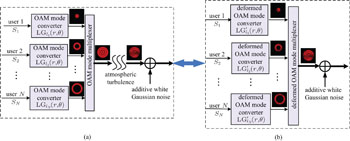 | Fig. 1. An equivalent MUD model for the OAM-multiplexed FSO communication link disturbed by AT. (a) The OAM-multiplexed FSO system; (b) an equivalent MUD system. |
The analysis of the equivalent MUD model is presented as follows.
Laser light with a Laguerre–Gaussian (LG) amplitude distribution is found to have a well-defined orbital–angular momentum.[41,42] LG mode can be expressed as[22]



Turbulence aberration occurs when the multiplexed OAM beams transmit through the free-space optical link. Here, a thin sheet phase screens model is used to simulate the aberration. The spatial variation caused by AT can be approximated by several thin sheets with random phase screen φ(r,θ) that modify the phase profile of the propagating beam.[43] According to the principle of the wave propagation, the multiplexed OAM beams before the first random phase screen would be


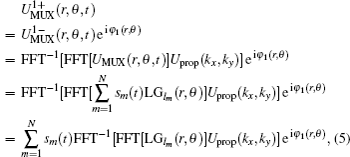
The procedure is repeated until the last random phase screen is reached. Therefore, the multiplexed OAM beams after the turbulent aberration channel are
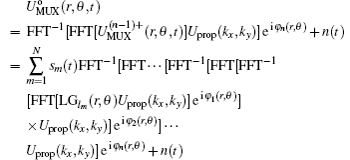







Equation (
It is shown that equation (






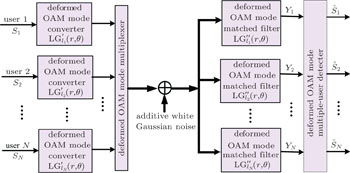 | Fig. 2. The turbulence mitigation scheme based on MUD for the OAM-multiplexed FSO communication link. |
Therefore, the received signal for the k-th user yk(t) through deformed OAM mode matched filter can be given as






Moreover, by dividing both sides of Eq. (



From Eq. (

For all the users, the received signals are given as

The corresponding matrix formula is



The cross-correlation matrix 




If

This is called de-correlating MUD method. It is shown that the de-correlating MUD method can effectively cancel the interference between users. Importantly, the de-correlating MUD method makes the interference caused by AT become a useful component to obtain the users’ information. As displayed in Eq. (
Of course, the matrix
In this section, we discuss the effect of the proposed turbulence mitigation scheme by numerical simulations. We use 10 random phase screens to approximate AT disturbance. The transmitting distance z is 1000 m, and the space distance between the successive random phase screens is ΔZ = 100 m. The inner scale size of phase screen is l0 = 1 mm, the outer scale size of phase screen is L0 = 50 m. The size of the phase screen is 128 × 128 with grid spacing Δx = 2 mm. The structure constant of the index of refraction 
Figure 
Figure 


Figure 
In order to demonstrate the mitigation effect of the proposed scheme on the crosstalk, figure 
In this paper, we have proposed a MUD idea turbulence mitigation scheme for the OAM-multiplexed FSO communication link. First, we have presented a MUD equivalent communication model for the OAM-multiplexed FSO communication link disturbed by AT. In the equivalent model, the crosstalk caused by AT is moved from the channel to the transmitter and used as the correlations between the users. Then, we have given an MUD solution for the equivalent model to enhance the AT tolerance of the OAM-multiplexed FSO communication link. In the scheme, the crosstalk caused by AT is not regarded as noise but is regarded as a useful component to obtain the users’ information. The results have shown that the proposed mitigation scheme can effectively improve the AT tolerance of the OAM-multiplexed FSO communication link. For the four OAM-multiplexed FSO communication links with the transmitted OAM spatial modes lm = {+1,+2,+3,+4}, the BER performance with the proposed scheme is close to 10−5, which is a 2–3 fold increase in comparison with those results without the MUD mitigation scheme. Here, 
| 1 | |
| 2 | |
| 3 | |
| 4 | |
| 5 | |
| 6 | |
| 7 | |
| 8 | |
| 9 | |
| 10 | |
| 11 | |
| 12 | |
| 13 | |
| 14 | |
| 15 | |
| 16 | |
| 17 | |
| 18 | |
| 19 | |
| 20 | |
| 21 | |
| 22 | |
| 23 | |
| 24 | |
| 25 | |
| 26 | |
| 27 | |
| 28 | |
| 29 | |
| 30 | |
| 31 | |
| 32 | |
| 33 | |
| 34 | |
| 35 | |
| 36 | |
| 37 | |
| 38 | |
| 39 | |
| 40 | |
| 41 | |
| 42 | |
| 43 |



